Why you can trust Tom's Hardware
Comparison Products
The Teamgroup MP44S goes up against other M.2 2230 SSDs that we have tested, including the Rocket 2230, the Corsair MP600 Mini, the older Inland TN436, the newer Inland TN446, and the similar Sabrent Rocket Q4 2230 and Addlink S91. The WD SN740, not shown, is a shorter OEM version of the WD Black SN770. The Micron 2400, also not shown, is similar to the Crucial P3 Plus but with an SMI controller — it should be somewhat less efficient. These two drives may be referenced where applicable but are not explicitly reviewed.
Steam Deck - General
To gauge general Steam Deck performance, we engage in a variety of typical storage situations with active time measurement. These activities include dealing with the default SteamOS through initial setup, re-imaging, initial booting, and booting in general. For game testing, we see how long it takes to install and boot the popular title Hollow Knight. For a full explanation of our testing procedure, see our Steam Deck storage testing article.


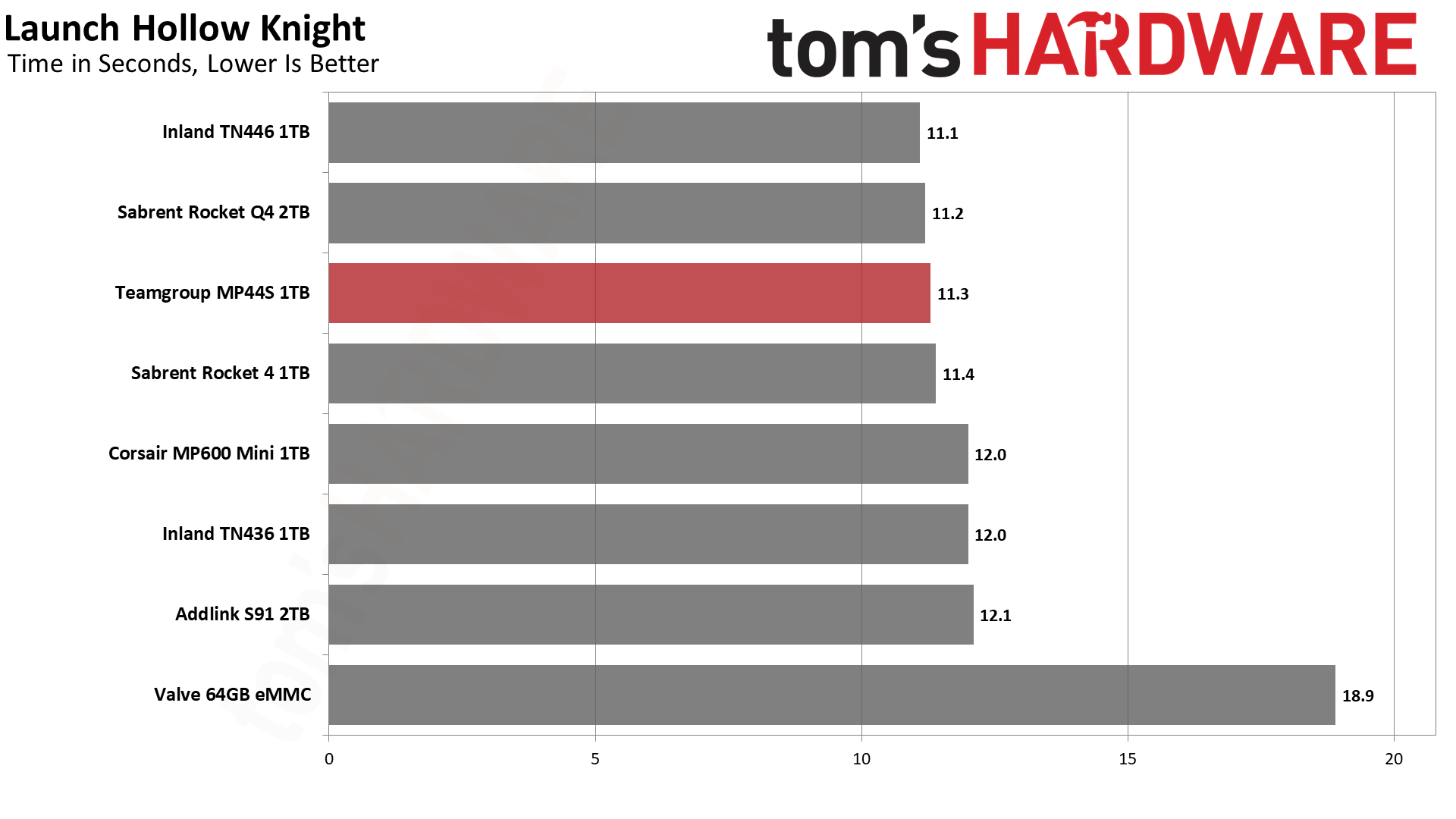



No anomalies were spotted with the MP44S in general Deck testing. You will get good performance from this drive when engaging in basic operations, and it works perfectly well with the Deck. This helps confirm that QLC, even at 1TB, is perfectly capable, although the drives must be less expensive. QLC still has its weaknesses, and keeping more space free to mitigate these means adjusting capacity per dollar must be made when picking a drive.
Steam Deck - KDiskMark and Temperature
One of the most popular, if not the most popular, storage benchmarks is CrysalDiskMark (CDM), which we use in our own Windows-based SSD testing suite. This benchmark relies on Microsoft’s DiskSpd with templated test settings. CDM lets you quickly see how a drive performs against its idealized, rated specifications and the benchmark can also hint at a more “real world” feel with low queue depth I/O testing.
The Linux flavor of this benchmark, which is easy to install on the Steam Deck, is KDiskMark. The “K” refers to the KDE desktop environment used on the Deck. KDiskMark relies on the Flexible I/O tester, or FIO, instead of DiskSpd. For the temperature portion we use data from the SMART sensors on the drive which can be directly polled and from which the maximum temperature can be extracted.

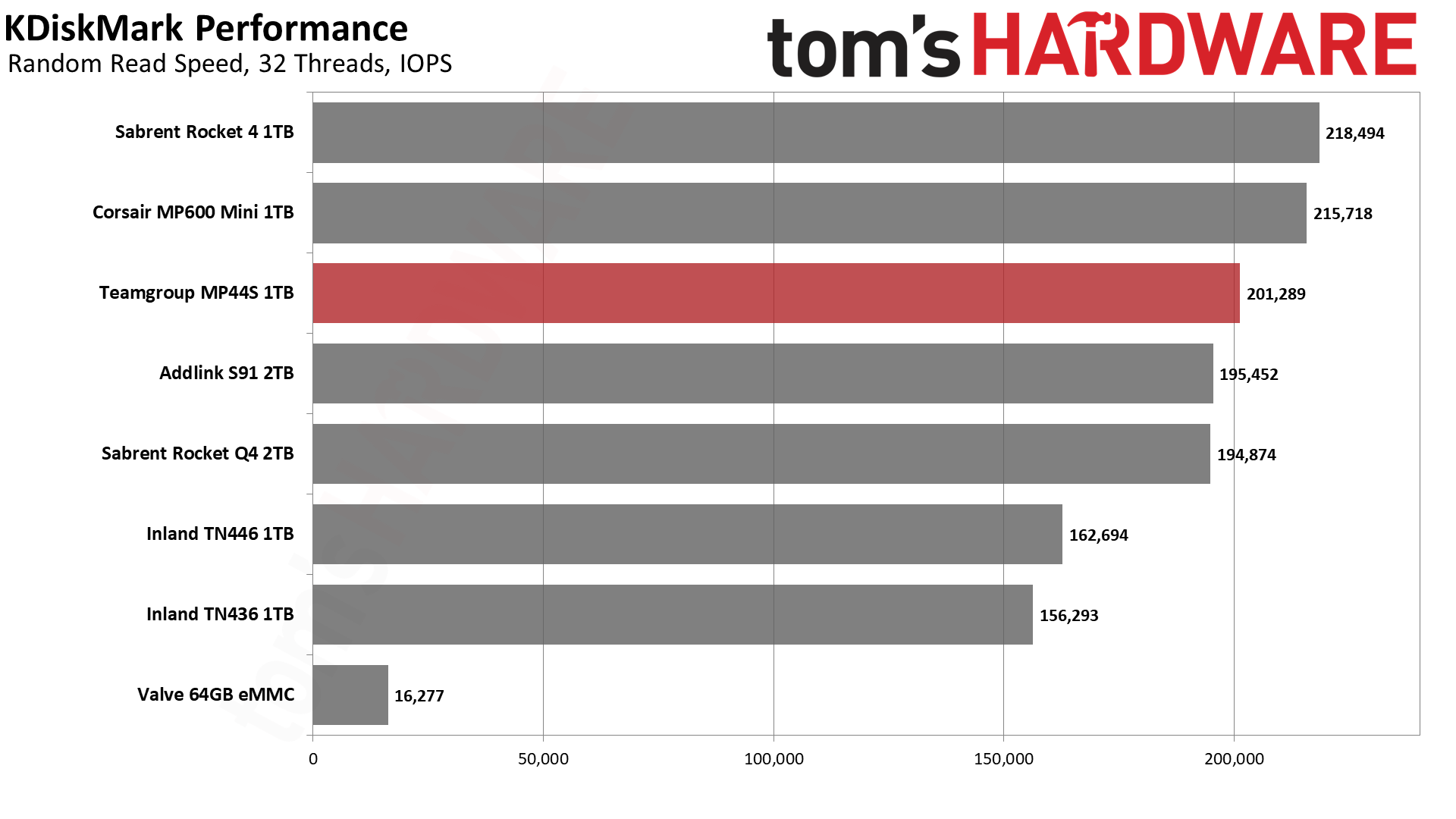

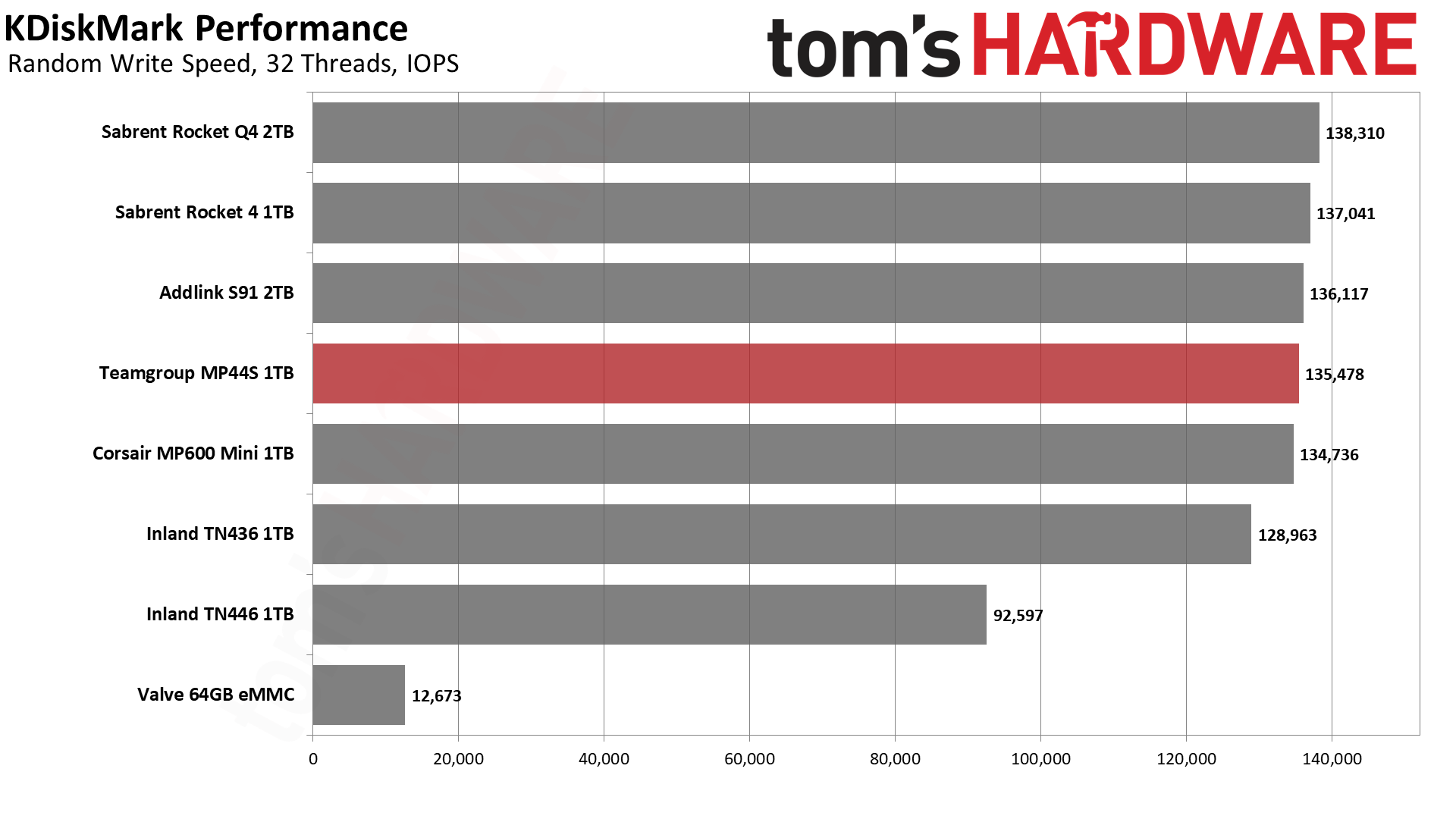




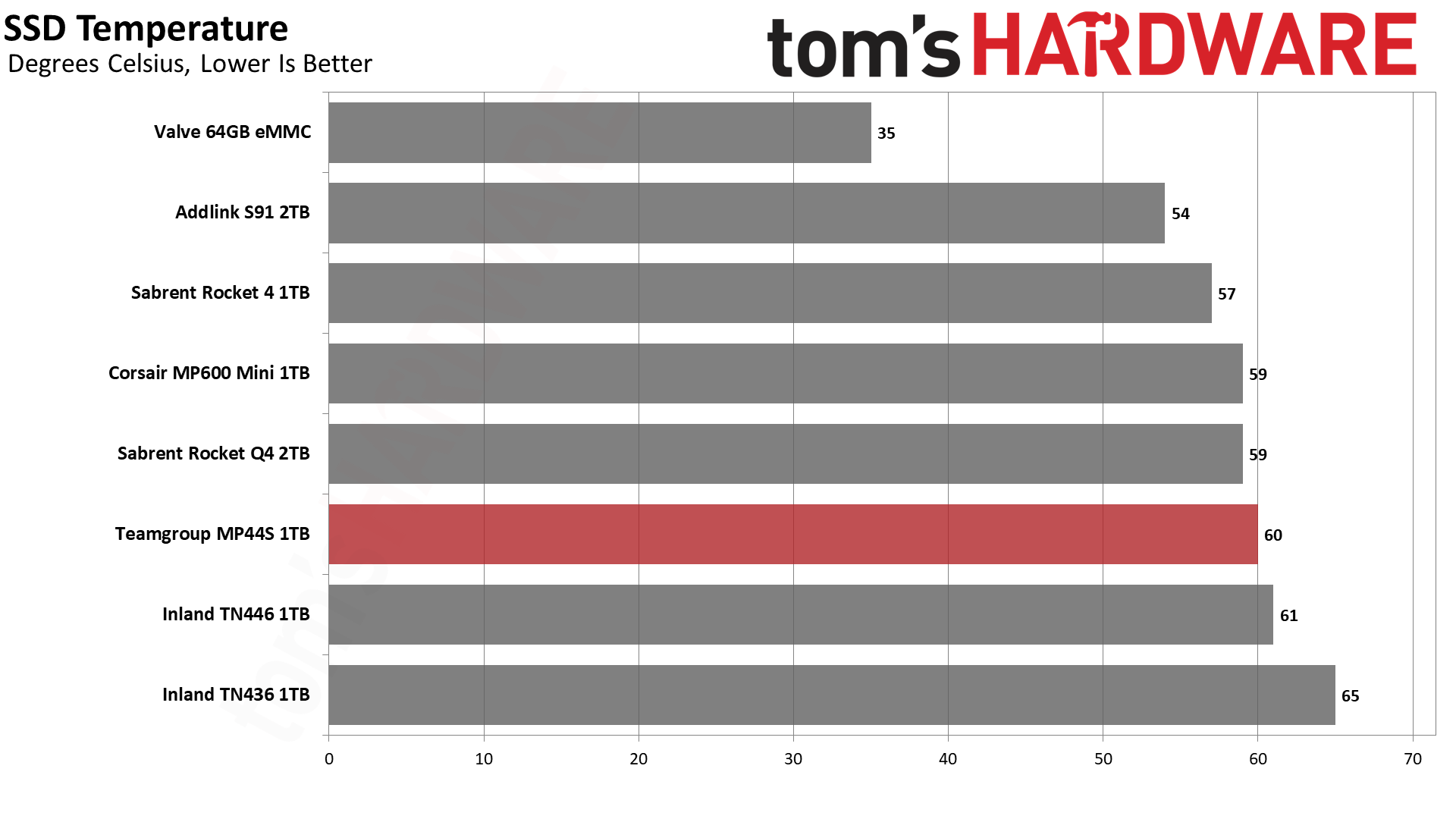
The MP44S is on the level with the other QLC drives, like the Rocket Q4 2230 and S91, which keeps it from being as fast as the newer TLC ones in the all-important low queue depth random 4KB read metric. It is faster than the older TN436 and the Deck’s 64GB stock drive, though.
Other disparities will differ when the drives are utilized in a PCIe 4.0 device like the ROG Ally. This is not hugely relevant for real-world performance and feel, but there is a difference, and certain edge cases — like sustained writes with a fuller drive — will favor the TLC options. The MP44S doesn’t appear fazed, with only 1TB compared to the 2TB QLC drives.
Get Tom's Hardware's best news and in-depth reviews, straight to your inbox.
The MP44S does not run particularly hot or cold. Teamgroup does market the graphene label for its cooling properties, which may be of small benefit, but also may require EMI shield adjustment in the Deck.
PC Trace Testing - 3DMark Gaming Storage Benchmark
Built for gamers, 3DMark’s Storage Benchmark focuses on real-world gaming performance. Each round in this benchmark stresses storage based on gaming activities including loading games, saving progress, installing game files, and recording gameplay video streams.





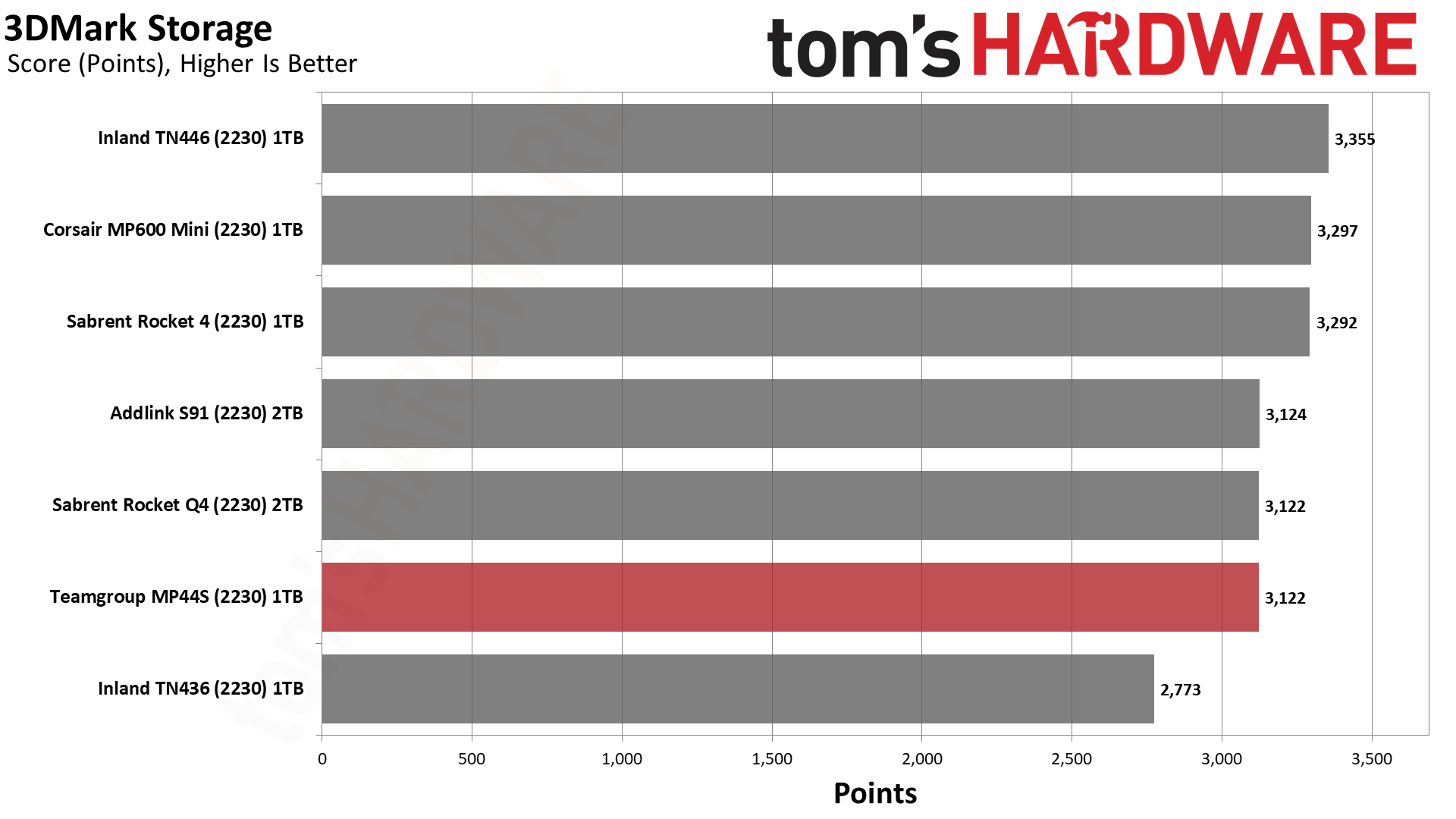
3DMark performance is fair, but the QLC-based solutions like the MP44S are slightly slower.
PC Trace Testing – PCMark 10 Storage Benchmark
PCMark 10 is a trace-based benchmark that uses a wide-ranging set of real-world traces from popular applications and everyday tasks to measure the performance of storage devices.






PCMark 10 is a surprise with the QLC drives — the MP44S, the Rocket Q4 2230, and the S91 — coming out on top. This is true regardless of interface speed or capacity. One place Micron’s QLC shines is with low queue depth 4KB writes, as demonstrated by our CrystalDiskMark results below.
PC Transfer Rates – DiskBench
We use the DiskBench storage benchmarking tool to test file transfer performance with a custom, 50GB dataset. We copy 31,227 files of various types, such as pictures, PDFs, and videos to a new folder and then follow-up with a reading test of a newly-written 6.5GB zip file.


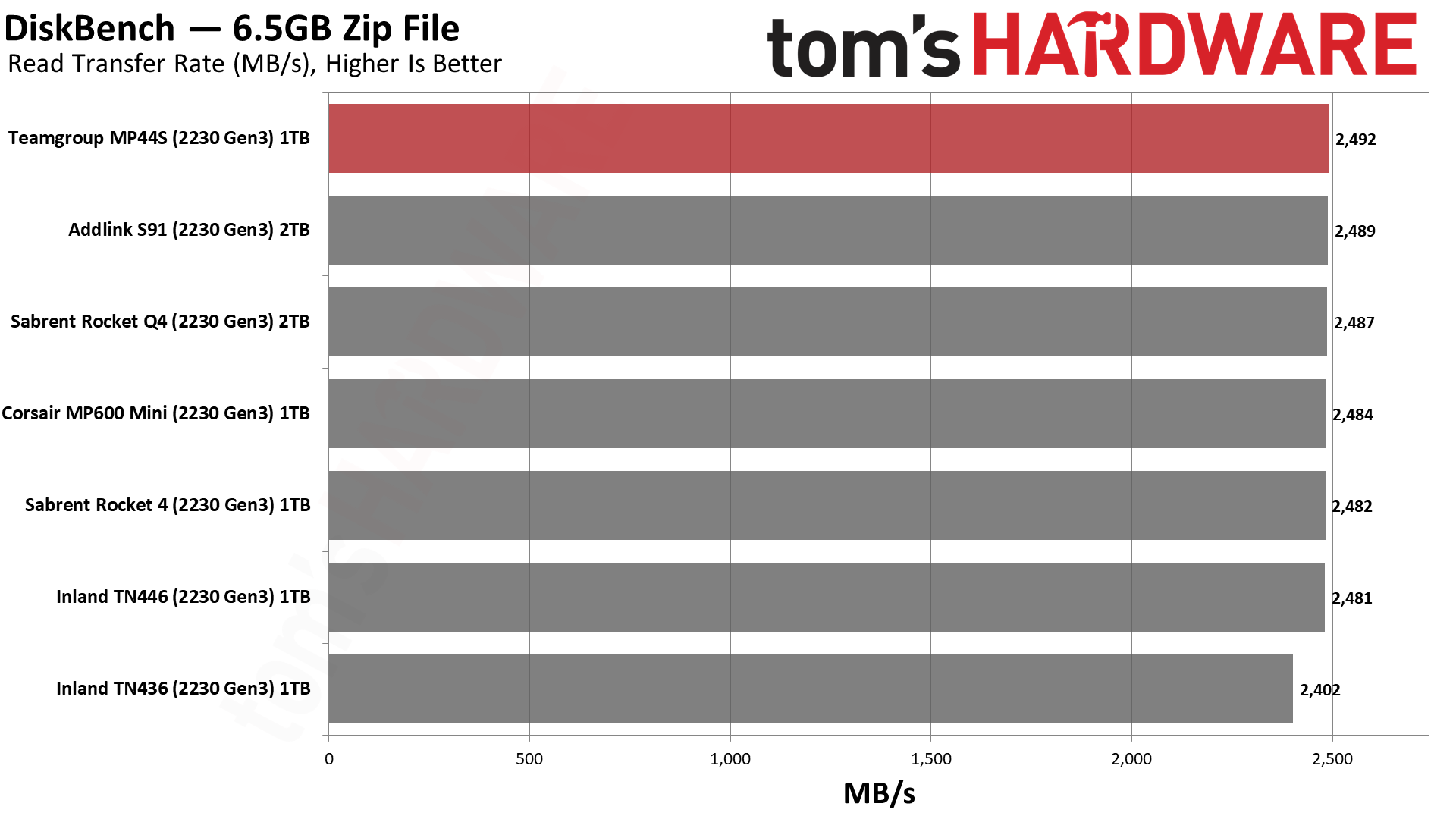


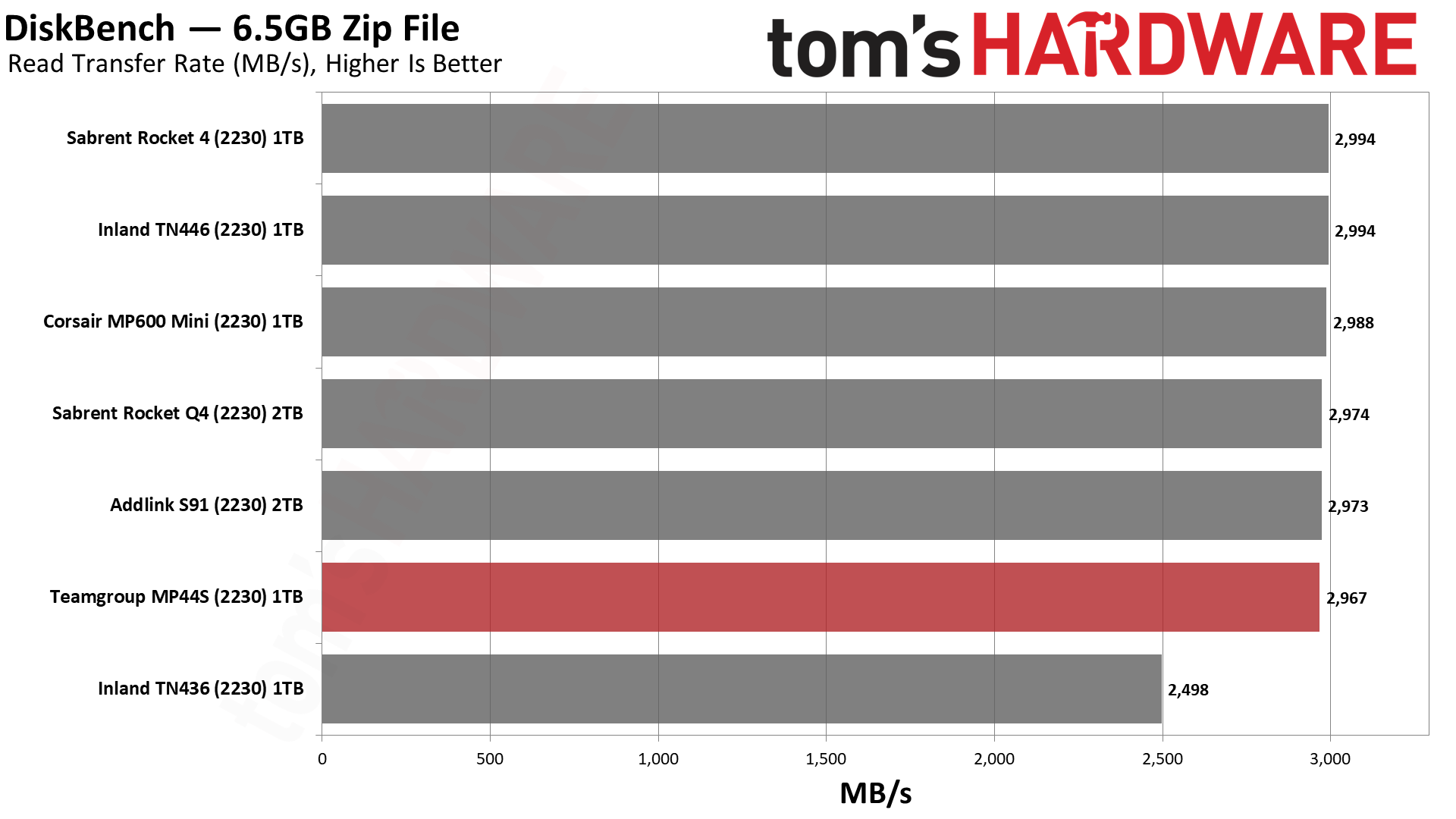
FIle copy performance is good for a PCIe 3.0 interface, as would be the case on the Steam Deck. When the drives are opened up to the PCIe 4.0 interface, the TLC-based solutions like the Rocket 2230, the MP600 Mini, and the TN446 pull ahead.
PC Synthetic Testing - ATTO / CrystalDiskMark
ATTO and CrystalDiskMark (CDM) are free and easy-to-use storage benchmarking tools that SSD vendors commonly use to assign performance specifications to their products. Both of these tools give us insight into how each device handles different file sizes.
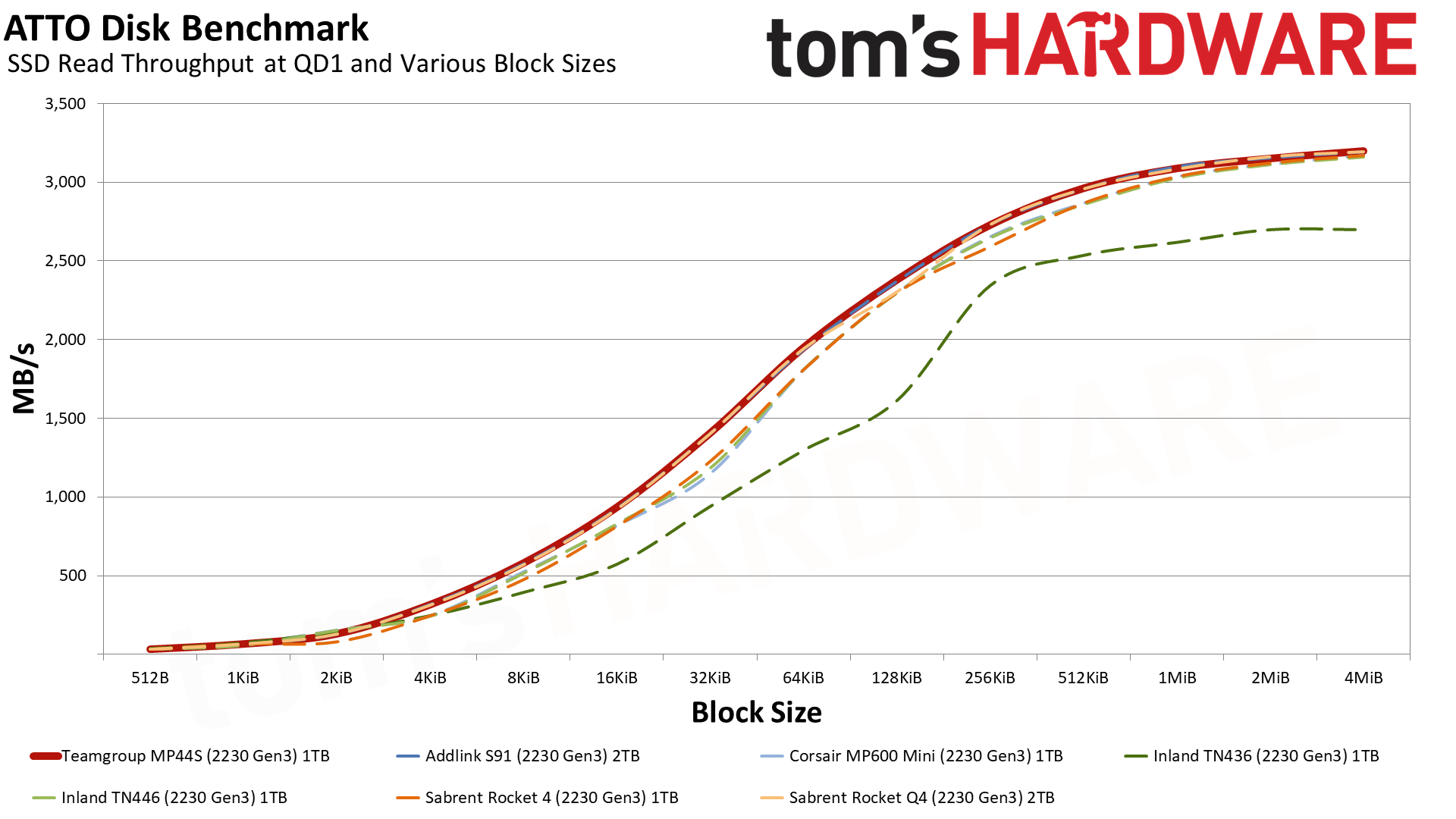







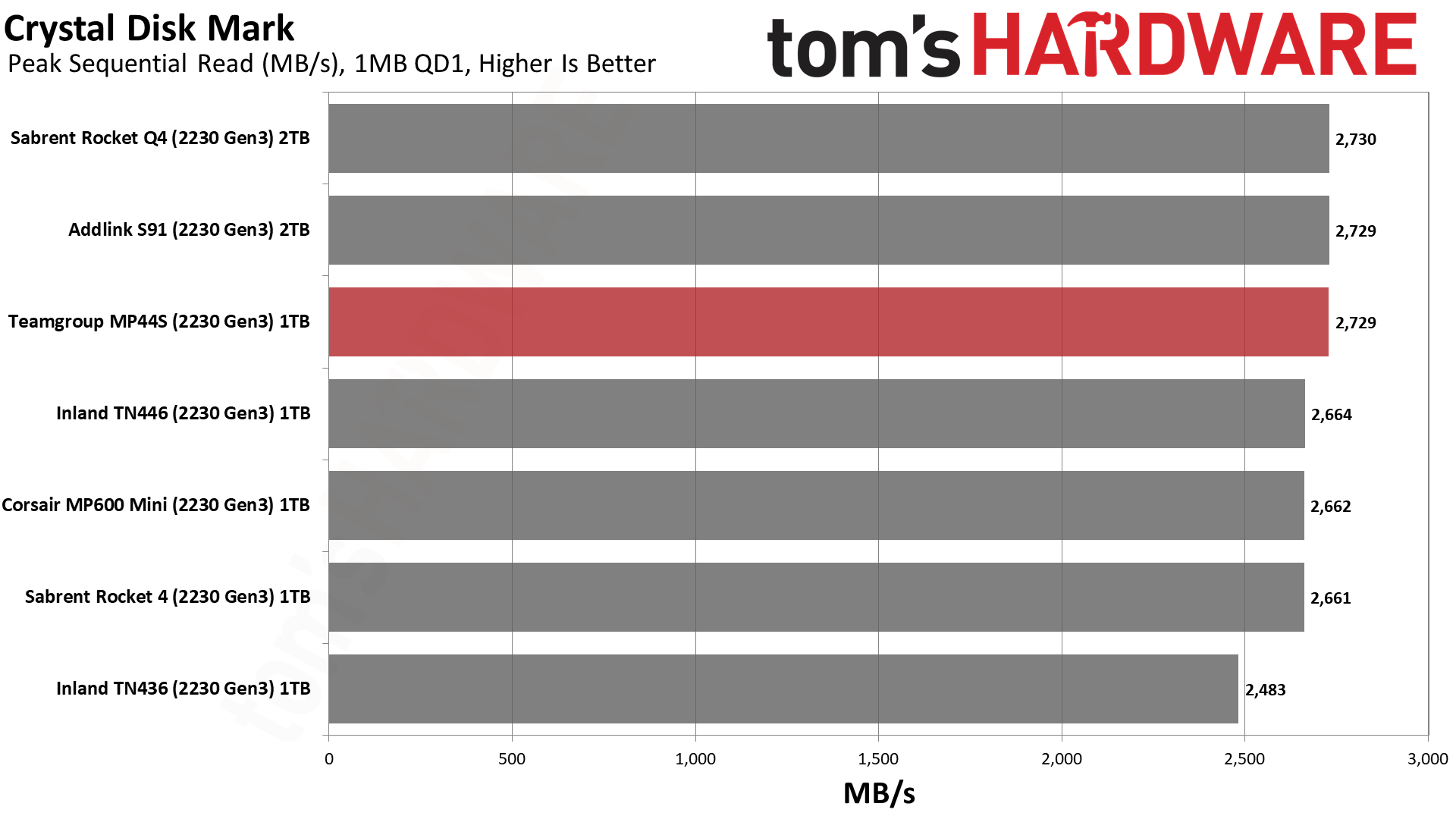







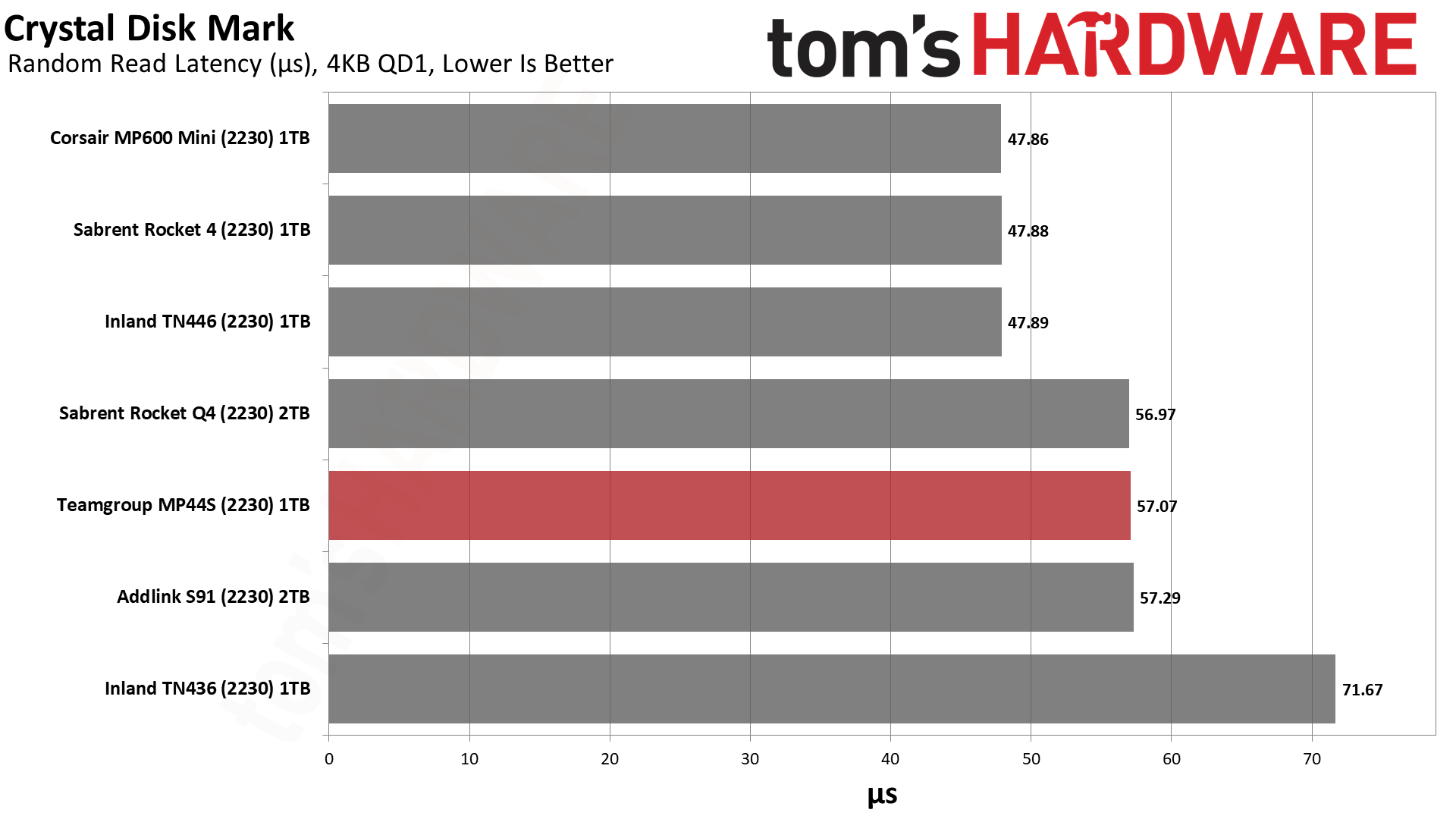

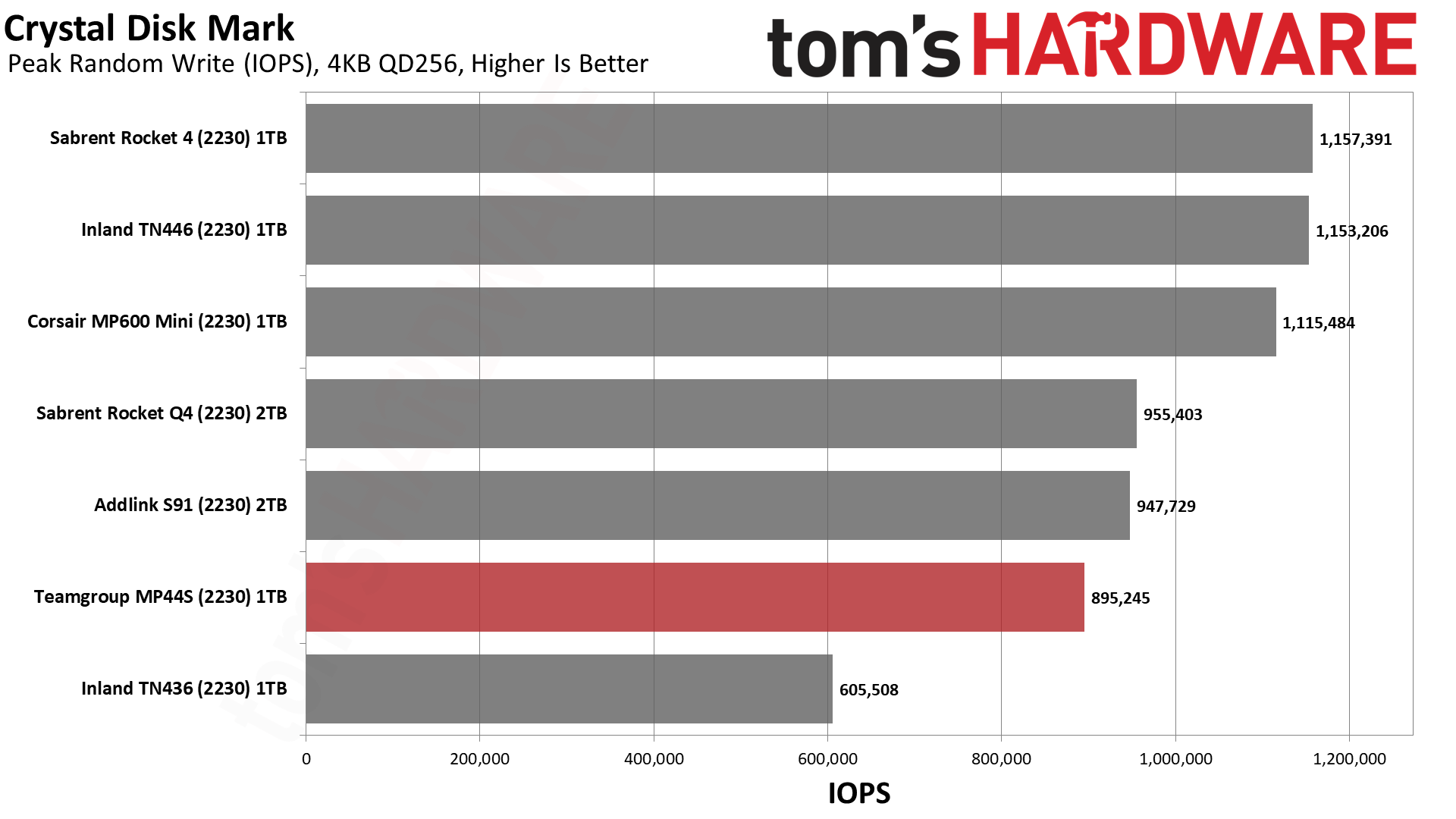





The ATTO results are good both for PCIe 3.0 and 4.0. Write throughput drops a bit with larger block sizes for the latter due to the limitations of QLC flash at the rated bus speed. Likewise, sequential performance in CDM is good at PCIe 3.0 speeds, with a significant gap for sequential writes with PCIe 4.0. Random write latency is good with this flash, but the arguably more important random read latency is worse with QLC.
PC Sustained Write Performance and Cache Recovery
Official write specifications are only part of the performance picture. Most SSDs implement a write cache, which is a fast area of (usually) pseudo-SLC programmed flash that absorbs incoming data. Sustained write speeds can suffer tremendously once the workload spills outside of the cache and into the "native" TLC or QLC flash.
We use Iometer to hammer the SSD with sequential writes for 15 minutes to measure both the size of the write cache and performance after the cache is saturated. We also monitor cache recovery via multiple idle rounds.


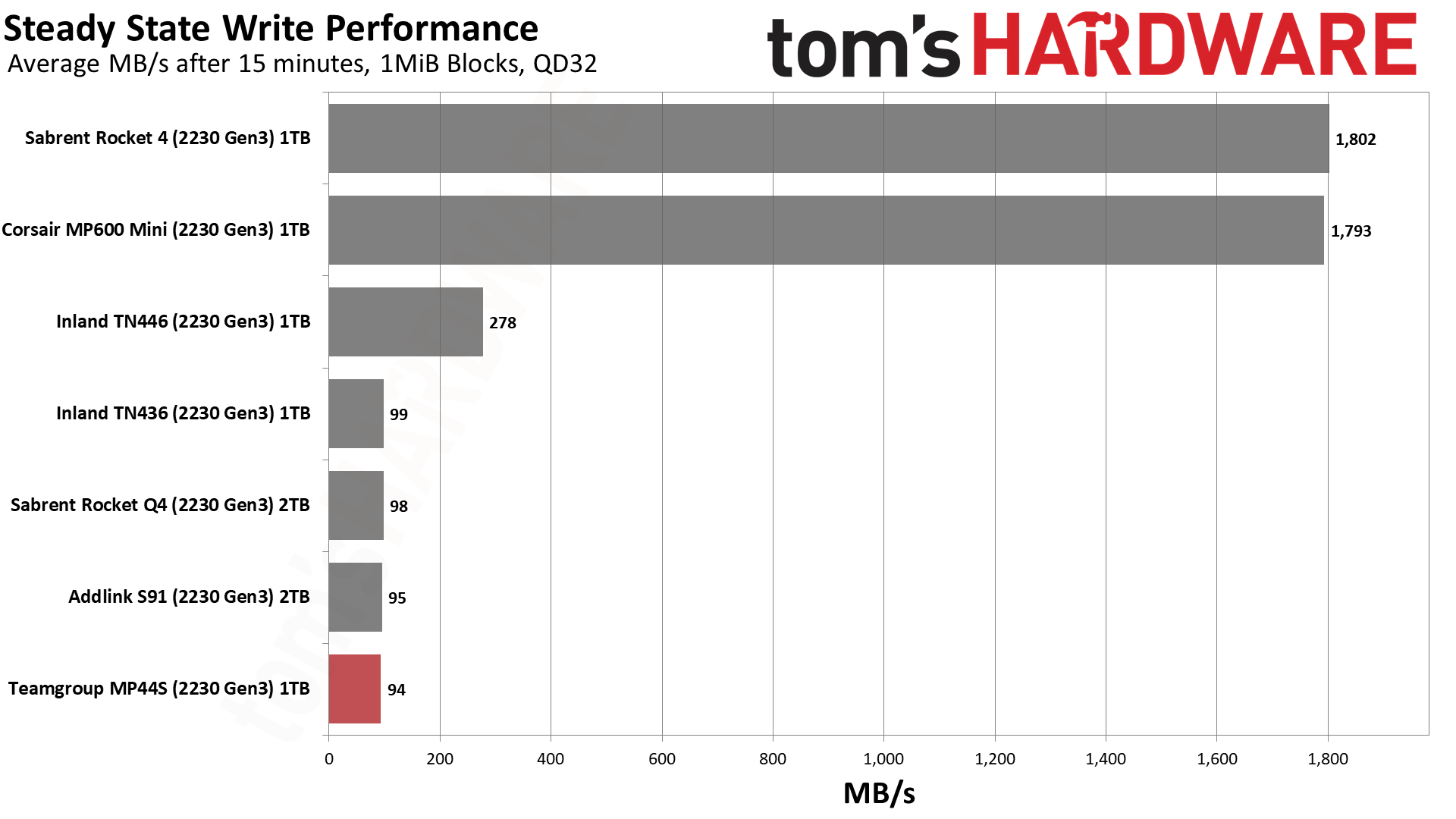


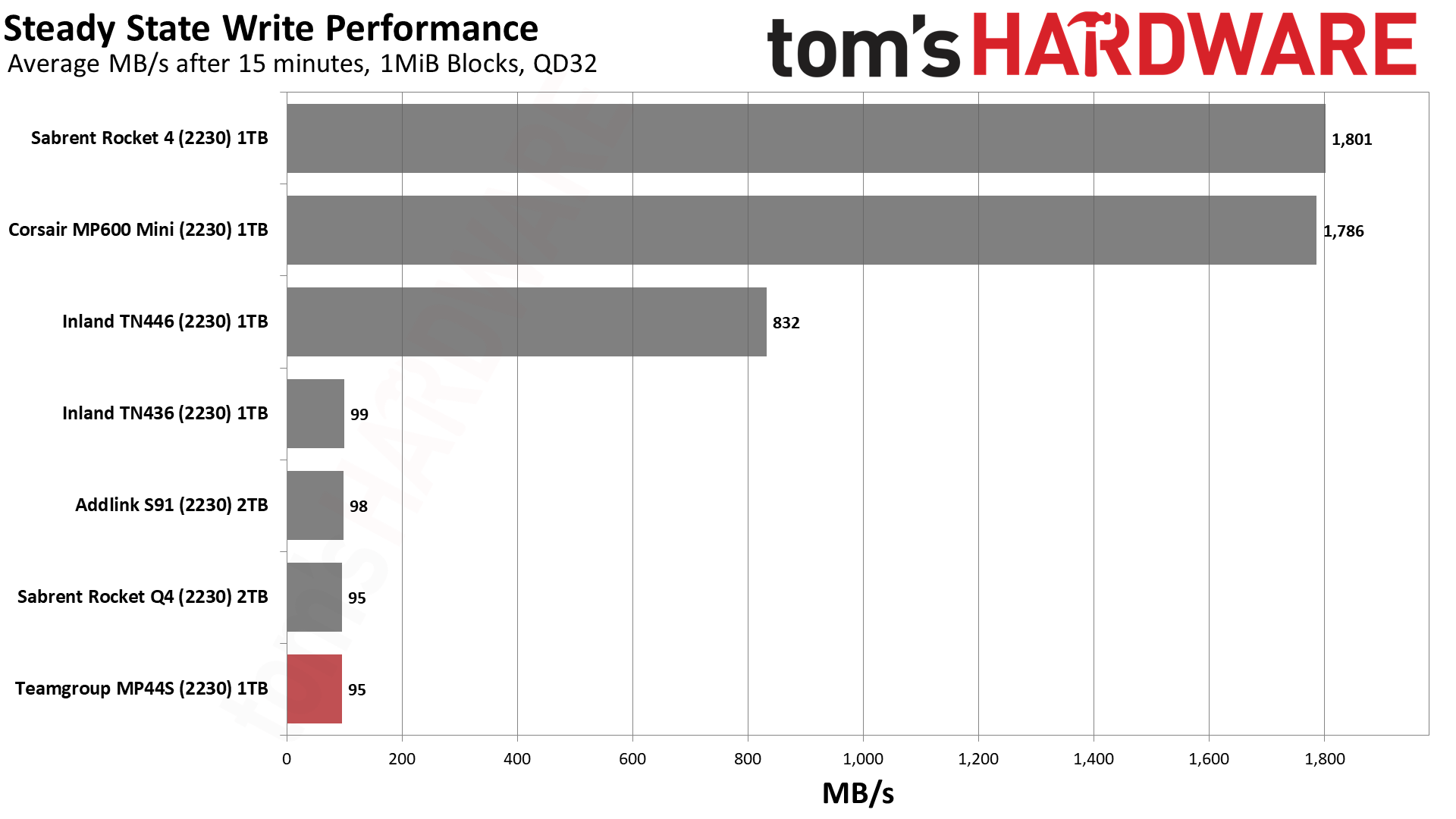
It’s hard to be satisfied by the slow, steady state write performance of the QLC-based drives, which includes the MP44S. They ultimately write at only about 100 MB/s in the QLC folding mode. This is due to the large cache and the flash’s low raw writing speed. Normally, this performance drop is not noticed as the drives will stay in pSLC mode. However, prolonged writing and/or a very full drive can make this condition arise more readily. The good news is that this QLC is fast enough to saturate with just eight dies for 1TB of capacity, although the cache is correspondingly smaller in absolute terms.
This is certainly one reason to look for a TLC drive, but even that is no guarantee of consistent performance, as demonstrated by the TN436. It’s a good idea to get more capacity than you need and try to leave some space free on the drive, especially with QLC. That means that going with, say, a 512GB TLC Rocket 2230 might be an attractive alternative to 1TB of QLC, but pricing is such that the best capacity per dollar is currently fixed at 1TB.
Power Consumption
We use the Quarch HD Programmable Power Module to gain a deeper understanding of power characteristics. Idle power consumption is an important aspect to consider, especially if you're looking for a laptop upgrade as even the best ultrabooks can have mediocre storage.
Some SSDs can consume watts of power at idle while better-suited ones sip just milliwatts. Average workload power consumption and max consumption are two other aspects of power consumption, but performance-per-watt is more important. A drive might consume more power during any given workload, but accomplishing a task faster allows the drive to drop into an idle state more quickly, ultimately saving energy.
For temperature recording we currently poll the drive’s primary composite sensor during testing with a 24C ambient.








Power efficiency is pretty stellar, although not quite as good as the best TLC drives. All of these drives are more efficient when run at PCIe 3.0 than 4.0, albeit not by a huge amount. They all also easily surpass the older TN436.
The 1TB MP44S has fewer dies than the 2TB S91 and Rocket Q4 2230 but has similar performance, which means it is more efficient — almost on par with the TLC drives. This indicates that any decision between QLC and TLC at 1TB will not have power efficiency as a significant factor.
The MP44S also ran cooler than our 2TB QLC drives, exhibiting no throttling. Efficiency often correlates with temperature, all else being equal. We wouldn’t put too much faith into the graphene label being able to make a meaningful difference in cooling, but it’s there.
Test Bench and Testing Notes
| CPU | Intel Core i9-12900K |
| Motherboard | Asus ROG Maximus Z790 Hero |
| Memory | 2x16GB G.Skill DDR5-5600 CL28 |
| Graphics | Intel Iris Xe UHD Graphics 770 |
| CPU Cooling | Enermax Aquafusion 240 |
| Case | Cooler Master TD500 Mesh V2 |
| Power Supply | Cooler Master V850 i Gold |
| OS Storage | Sabrent Rocket 4 Plus 2TB |
| Operating System | Windows 11 Pro |
We use an Alder Lake platform with most background applications such as indexing, Windows updates, and anti-virus disabled in the OS to reduce run-to-run variability. Each SSD is prefilled to 50% capacity and tested as a secondary device. Unless noted, we use active cooling for all SSDs.
Conclusion
There’s not too much to differentiate the MP44S from the Addlink S91 and Sabrent Rocket Q4 2230. It does have a graphene label with similar aspirations as the copper-infused one utilized by Sabrent, although there’s a real limit to how much this will help in a confined space. It also has an SSD toolbox, but that’s pretty standard for the industry, and even if it wasn’t available, there are excellent freeware solutions for most features. Teamgroup’s reputation is not the worst, so it may be a better solution than some shady generic brands, but your decision still comes down to price at the end of the day.
We have nothing bad to say about the MP44S, and it doesn’t have the inconsistencies we saw with the S91. The S91 has a 512GB TLC option, but if we’re talking about high capacity, the Q4 2230 is also a real competitor. Other 2TB options are available on the wider market, including the WD Black SN740 and Crucial 2400, but these were designed for OEM uses. Money can be saved by going to sites like AliExpress to find those types of drives, but there may be more risk involved. The MP44S is, therefore, a relatively safe option if you’re willing to potentially pay more. It’s not half bad at 1TB, but it has to undercut the TLC alternatives to be worthwhile.
The real question is, is it worth going with QLC flash if you're looking for 1TB of storage? Given current pricing, it really seems best to use QLC for 2TB if you want capacity and, if you want maximum performance on a budget, stick with TLC at 512GB with a drive like the TN446. If you have your heart set on 1TB, then the price difference between QLC and TLC is narrow enough to lean in TLC’s favor if performance and full-drive consistency are factors for you.
Still, the 1TB MP44S performed well enough at PCIe 3.0 and in the Steam Deck to suggest you can get by with QLC flash without any large performance gap. It’s just a matter of how much you’re willing to spend or save.
MORE: Best SSDs
MORE: Best External SSDs and Hard Drives
MORE: How We Test HDDs And SSDs
MORE: All SSD Content

Shane Downing is a Freelance Reviewer for Tom’s Hardware US, covering consumer storage hardware.
